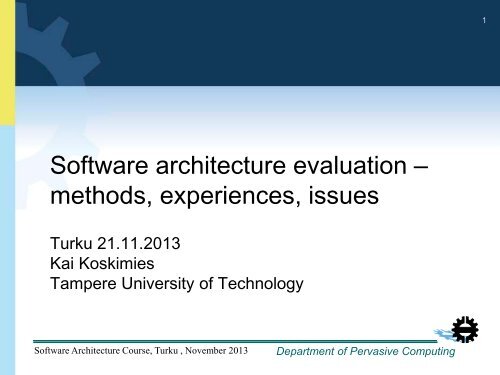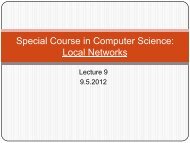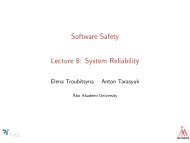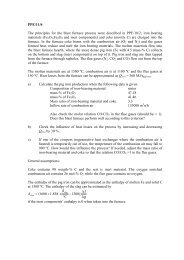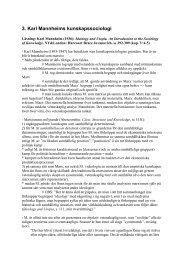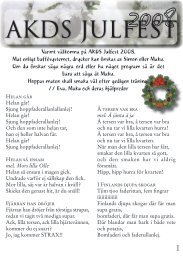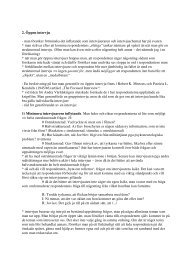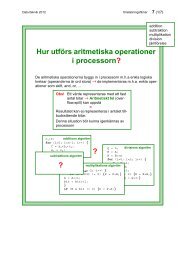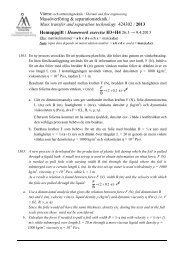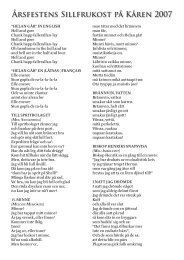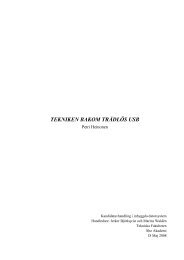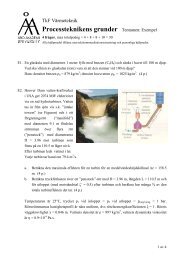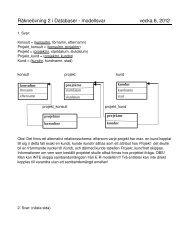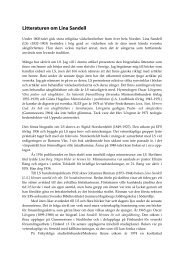Software architecture evaluation – methods, experiences, issues
Software architecture evaluation – methods, experiences, issues
Software architecture evaluation – methods, experiences, issues
Create successful ePaper yourself
Turn your PDF publications into a flip-book with our unique Google optimized e-Paper software.
1<br />
<strong>Software</strong> <strong>architecture</strong> <strong>evaluation</strong> <strong>–</strong><br />
<strong>methods</strong>, <strong>experiences</strong>, <strong>issues</strong><br />
Turku 21.11.2013<br />
Kai Koskimies<br />
Tampere University of Technology<br />
<strong>Software</strong> Architecture Course, Turku , November 2013<br />
Department of Pervasive Computing
2<br />
Contents<br />
• Introduction & background<br />
• <strong>Software</strong> <strong>architecture</strong> <strong>evaluation</strong> as information source<br />
• Challenges in scenario-based <strong>evaluation</strong><br />
• DCAR: Decision-based software <strong>architecture</strong> <strong>evaluation</strong><br />
• Conclusions<br />
<strong>Software</strong> Architecture Course, Turku , November 2013<br />
Department of Pervasive Computing
Background<br />
3<br />
Two nationally funded research projects with global machine<br />
manufacturers (John Deere, Sandvik, Metso, Kone, Areva, +<br />
software subcontractors) in 2007-2011.<br />
Aims: Improving <strong>architecture</strong> work practices for machine control<br />
systems<br />
About 20 ”real-life” architectural <strong>evaluation</strong>s carried out in industry<br />
<strong>Software</strong> Architecture Course, Turku , November 2013<br />
Department of Pervasive Computing
SA <strong>evaluation</strong> problem<br />
4<br />
Quality<br />
requirements<br />
?<br />
<strong>Software</strong><br />
<strong>architecture</strong><br />
<strong>Software</strong> Architecture Course, Turku , November 2013<br />
Department of Pervasive Computing
Scenario-based approach: use<br />
scenarios as test cases<br />
5<br />
Quality<br />
requirements<br />
?<br />
<strong>Software</strong><br />
<strong>architecture</strong><br />
Refining<br />
requirements<br />
Identification<br />
of solutions<br />
Scenarios<br />
Analysis<br />
Architectural<br />
decisions<br />
<strong>Software</strong> Architecture Course, Turku , November 2013<br />
Department of Pervasive Computing
Evaluation reports: first format<br />
6<br />
Grouped according to<br />
quality attribute<br />
Architectural solutions<br />
extracted from analysis<br />
Risks identified on the<br />
basis of analysis<br />
Main problems:<br />
Unstructured analysis<br />
Few architectural<br />
solutions identified<br />
<strong>Software</strong> Architecture Course, Turku , November 2013<br />
Department of Pervasive Computing
Evaluation reports: second format<br />
7<br />
Flat list of analyzed scenarios (in priority<br />
order)<br />
All solutions identified beforehand<br />
Scenario-related solutions identified &<br />
analyzed<br />
Risks, non-risks and trade-offs identified<br />
from solution analysis<br />
Main problems:<br />
The scenario ”disappears”: difficult to get an<br />
overview of the scenario (how is the<br />
scenario managed as a whole?)<br />
Sometimes repeating ”trivial” information<br />
<strong>Software</strong> Architecture Course, Turku , November 2013<br />
Department of Pervasive Computing
Evaluation reports: final format<br />
8<br />
Scenario description<br />
List of architectural decisions that are<br />
potentially involved in the scenario<br />
The architect’s explanation on how to<br />
manage the scenario<br />
Explanation of how the architectural<br />
decision is related to this scenario,<br />
identification of possible problems<br />
<strong>Software</strong> Architecture Course, Turku , November 2013<br />
Department of Pervasive Computing
Exploiting SA <strong>evaluation</strong> for<br />
information mining<br />
9<br />
Architecture<br />
Architecture<br />
<strong>evaluation</strong><br />
Risks<br />
Requirements<br />
?<br />
<strong>Software</strong> Architecture Course, Turku , November 2013<br />
Department of Pervasive Computing
Example: Pattern mining<br />
10<br />
Architecture<br />
Requirements<br />
Architecture<br />
<strong>evaluation</strong><br />
Risks<br />
Design patterns<br />
(domain-oriented)<br />
<strong>Software</strong> Architecture Course, Turku , November 2013<br />
Department of Pervasive Computing
Pattern language for machine control<br />
11<br />
Patterns identified as a<br />
sideprocess of architectural<br />
<strong>evaluation</strong> (as solutions)<br />
Aiming at a full generative<br />
pattern language for<br />
machine control systems<br />
Several novel patterns,<br />
many existing patterns<br />
Patterns elaborated in<br />
VikingPLoPs and<br />
EuroPLoPs<br />
<strong>Software</strong> Architecture Course, Turku , November 2013<br />
Department of Pervasive Computing
Architecture Knowledge Management<br />
(AKM)<br />
12<br />
• AKM is about approaches, <strong>methods</strong>, and techniques for capturing<br />
and using architectural knowledge<br />
• Design (and architectural) patterns are one way to express general<br />
architectural knowledge<br />
• Many proposals exist for tools to store and retrieve architectural<br />
knowledge (see e.g. M. Ali Babar et al (eds.), Architecture<br />
Knowledge Management <strong>–</strong> Theory and Practice, Springer 2009)<br />
<strong>Software</strong> Architecture Course, Turku , November 2013<br />
Department of Pervasive Computing
Frustrating experience …<br />
13<br />
• In a recent research project with industrial partners, AKM<br />
approaches were developed involving attractive (we<br />
thought) benefits e.g. in automating document production.<br />
• Still, in spite of generally positive attitude among the<br />
practitioners, the partners did not see the cost-benefit ratio<br />
attractive enough to actually try out the approaches in an<br />
industrial context.<br />
• Are these people stupid or what?<br />
<strong>Software</strong> Architecture Course, Turku , November 2013<br />
Department of Pervasive Computing
Problem: Feeding the beast<br />
14<br />
<strong>Software</strong> Architecture Course, Turku , November 2013<br />
Department of Pervasive Computing
Problem: Information bloat<br />
15<br />
Falessi et al. (TOSEM, to appear):<br />
only half of design rationale information<br />
in full documentation is probably needed<br />
<strong>Software</strong> Architecture Course, Turku , November 2013<br />
Department of Pervasive Computing
The management domination problem<br />
16<br />
• In any collaborative human activity that needs<br />
coordination, management and administration<br />
tend to take over in the long run<br />
• In software engineering, the counter reaction<br />
has been agile & lean<br />
• Can AKM be lean?<br />
<strong>Software</strong> Architecture Course, Turku , November 2013<br />
Department of Pervasive Computing
Lean AKM Manifesto<br />
17<br />
1. The producing and consuming of architectural information in AKM should not<br />
require extra effort. There should be no activities that are related only to AKM itself<br />
during the software system lifecycle.<br />
2. AKM should be invisible from the viewpoint of information producers and<br />
consumers. The producers and consumers should not need to be aware of AKM.<br />
AKM should be seamlessly integrated with usual knowledge-sharing activities like<br />
documentation, reviews and project meetings.<br />
3. Only potentially useful architectural information should be stored in AKM. All<br />
stored information is expected to be used in the context of a probable development<br />
or an evolution scenario. The burden of useless information surpasses the possible<br />
benefit of coincidental usage.<br />
<strong>Software</strong> Architecture Course, Turku , November 2013<br />
Department of Pervasive Computing
Architectural knowledge<br />
18<br />
Architectural Knowledge = Design Decisions + Design<br />
Kruchten 2006, Bosch 2004, Tyree et. al 2005<br />
• Can we produce (essential) design decisions information<br />
effortlessly?<br />
• Can we produce (essential) design information effortlessly?<br />
• Once we have this kind of information, can we satisfy the<br />
needs of stakeholders effortlessly?<br />
<strong>Software</strong> Architecture Course, Turku , November 2013<br />
Department of Pervasive Computing
Towards invisible AKM<br />
19<br />
Activities<br />
Tools<br />
Requirements<br />
specification<br />
Architectural<br />
<strong>evaluation</strong><br />
Meetings (e.g.<br />
retrospects)<br />
Architectural<br />
knowledge<br />
repository<br />
Virtual<br />
Architecture<br />
Informaticist<br />
Coding<br />
…<br />
<strong>Software</strong> Architecture Course, Turku , November 2013<br />
Department of Pervasive Computing
Observations<br />
20<br />
• Companies actually use ATAM-style <strong>evaluation</strong> also for<br />
learning the <strong>architecture</strong> and for producing (more covering) SA<br />
documentation, or information to be used in SA documentation<br />
• A lot of information potentially relevant for SA documentation<br />
comes up during ATAM-style <strong>evaluation</strong><br />
• Evolution scenarios capture probable situations where SA<br />
documentation is needed<br />
• Scenario analysis reveals more or less the relevant<br />
architectural information related to that evolution situation<br />
• Light-weight, ”good enough” documentation of SA can be<br />
produced with very little extra work as a side-effect of<br />
<strong>evaluation</strong><br />
<strong>Software</strong> Architecture Course, Turku , November 2013<br />
Department of Pervasive Computing<br />
21.11.2013
Example<br />
21<br />
Architectural<br />
decisions that have<br />
to be understood if<br />
the scenario gets<br />
realized<br />
Effectively<br />
instructions for<br />
changing/exploiting<br />
the <strong>architecture</strong> in<br />
case the evolution<br />
scenario gets<br />
realized<br />
<strong>Software</strong> Architecture Course, Turku , November 2013<br />
Department of Pervasive Computing<br />
21.11.2013
Architectural knowledge from ATAM<br />
22<br />
• Major architecturally significant requirements<br />
• Architecture design overview<br />
• Architectural decisions<br />
• Architectural & design patterns<br />
• Architect’s maintenance instructions (scenario analysis)<br />
• Known weaknesses of the <strong>architecture</strong><br />
In an experiment, about half of the AK repository contents<br />
originated from ATAM<br />
<strong>Software</strong> Architecture Course, Turku , November 2013<br />
Department of Pervasive Computing
Shortcomings in ATAM based AK<br />
23<br />
• No detailed & precise component <strong>architecture</strong><br />
Possible solution: using RE tools for extracting component<br />
structure from source code, when available<br />
• Some relationships between information items may be<br />
difficult to create on the fly (e.g. component <strong>–</strong> requirement)<br />
• Decisions are only identified and named<br />
<strong>Software</strong> Architecture Course, Turku , November 2013<br />
Department of Pervasive Computing
Towards invisible AKM<br />
24<br />
Activities<br />
Tools<br />
Requirements<br />
specification<br />
Architectural<br />
<strong>evaluation</strong><br />
Meetings (e.g.<br />
retrospects)<br />
Architectural<br />
knowledge<br />
repository<br />
Virtual<br />
Architecture<br />
Informaticist<br />
Coding<br />
…<br />
<strong>Software</strong> Architecture Course, Turku , November 2013<br />
Department of Pervasive Computing
Possible approach for SA informaticist:<br />
architectural slicing<br />
25<br />
• Task-based slicing<br />
Derivation of an information package addressing a specific task<br />
related to software <strong>architecture</strong><br />
• Process-based slicing<br />
Derivation of an information package corresponding to an artifact<br />
defined by the software development process<br />
• Item-based slicing<br />
Derivation of an information package collecting all information<br />
relevant to understand a specific item involved in software<br />
<strong>architecture</strong><br />
• Role-based slicing<br />
Derivation of an information package from the viewpoint of a<br />
specific stakeholder role<br />
(Eloranta et al. 2012)<br />
<strong>Software</strong> Architecture Course, Turku , November 2013<br />
Department of Pervasive Computing
26<br />
Example: Task-based slicing<br />
During maintenance, a maintainer is faced with a task of<br />
modifying the system and needs architectural guidance. The<br />
maintainer asks the Virtual SA informaticist to provide all<br />
architectural information relevant for the task.<br />
The Virtual SA informaticist compares the task to the existing<br />
<strong>evaluation</strong> scenarios, and if a sufficient match is found,<br />
generates an information package exploiting the relationships<br />
of the scenario item (e.g. related decisions and design items).<br />
<strong>Software</strong> Architecture Course, Turku , November 2013<br />
Department of Pervasive Computing
27<br />
Example: Process-based slicing<br />
At any time, the Virtual SA informaticist can be asked to<br />
provide a comprehensive software <strong>architecture</strong> documentation<br />
that reflects the system at a given time. The Virtual SA<br />
informaticist follows a predefined document template and fills<br />
in the contents required by the template.<br />
<strong>Software</strong> Architecture Course, Turku , November 2013<br />
Department of Pervasive Computing
28<br />
Example: Item-based slicing<br />
A person can be interested in a specific architectural item, for<br />
example a component. The Virtual SA informaticist can be<br />
asked to provide an information package focusing on that<br />
component, to be used e.g. by a person who is expected to<br />
implement or maintain that component. The Virtual SA<br />
informaticist makes use of the relationships of that item (e.g.<br />
usage contexts, decisions, requirements, interfaces etc.) and<br />
generates an architectural mini-document for the component.<br />
<strong>Software</strong> Architecture Course, Turku , November 2013<br />
Department of Pervasive Computing
29<br />
Example: Role-based slicing<br />
A manager needs an overview description of the architectural<br />
aspects of a product, emphasizing business drivers, very highlevel<br />
decisions, technological decisions, possible risk areas<br />
etc. The Virtual SA informaticist can be asked to provide such<br />
an information package by filtering out items that are irrelevant<br />
from the viewpoint of the given role.<br />
<strong>Software</strong> Architecture Course, Turku , November 2013<br />
Department of Pervasive Computing
TopDocs: Generating specialized software<br />
<strong>architecture</strong> documentation<br />
30<br />
Information<br />
emerging in<br />
architectural<br />
<strong>evaluation</strong><br />
Implemented on<br />
top of Polarion, a<br />
commercial ALM<br />
platform<br />
Eloranta et al. WICSA/ECSA 2012<br />
<strong>Software</strong> Architecture Course, Turku , November 2013<br />
Department of Pervasive Computing
Example: maintenance scenario<br />
documentation<br />
31<br />
Scenario<br />
evaluates<br />
Architectural<br />
decision<br />
concerns<br />
affects<br />
Requirement<br />
Architectural<br />
design<br />
child<br />
Need-oriented <strong>architecture</strong> documentation<br />
(Eloranta et al. ECSA 2012)<br />
<strong>Software</strong> Architecture Course, Turku , November 2013<br />
Department of Pervasive Computing
Challenges in scenario-based <strong>evaluation</strong><br />
32<br />
• Trustworthiness problem: can we rely on the<br />
outcome of the <strong>evaluation</strong>?<br />
• Heavy-weightness problem: can we afford the time<br />
& resources?<br />
<strong>Software</strong> Architecture Course, Turku , November 2013<br />
Department of Pervasive Computing
Trustworthiness problem<br />
33<br />
• Scenario-based <strong>evaluation</strong> can be self-deception: there is no<br />
inbuilt coverage concept, or characterization of the confidence<br />
level of the results of the <strong>evaluation</strong>.<br />
• Would the next not analyzed scenario reveal a problematic<br />
architectural decision or a compromised quality attribute?<br />
• Scenarios are prioritized by the stakeholders which may have<br />
their own agenda: “safe” scenarios often get prioritized<br />
<strong>Software</strong> Architecture Course, Turku , November 2013<br />
Department of Pervasive Computing
Heavy-weightness problem<br />
34<br />
• Medium-sized ATAM can take up to 70 person days<br />
• ATAM assumes the presence of many stakeholders that are<br />
difficult to get available at the same time<br />
• A lot of time is used to refine requirements<br />
• Incompatible with agile approaches (e.g. Scrum)<br />
<strong>Software</strong> Architecture Course, Turku , November 2013<br />
Department of Pervasive Computing
DCAR: decision-based <strong>architecture</strong><br />
<strong>evaluation</strong> method<br />
35<br />
Design = balancing the forces associated with a design problem<br />
Forces pull the solution of<br />
the problem towards<br />
a certain direction<br />
possible<br />
decision<br />
possible<br />
decision<br />
problem<br />
possible<br />
decision<br />
forces<br />
possible<br />
decision<br />
<strong>Software</strong> Architecture Course, Turku , November 2013<br />
Department of Pervasive Computing
For a decision, forces are positive or<br />
negative<br />
36<br />
Example:<br />
Problem: traditional DB<br />
leads to slow response of<br />
an application<br />
Solution: use an inmemory<br />
DB system<br />
<strong>Software</strong> Architecture Course, Turku , November 2013<br />
Department of Pervasive Computing
DCAR process<br />
37<br />
Identify forces that<br />
have influence on<br />
the <strong>architecture</strong><br />
Identify <strong>architecture</strong><br />
design decisions<br />
Prioritize design<br />
decisions<br />
Document design<br />
decisions (with<br />
forces)<br />
Evaluate design<br />
decisions against<br />
forces<br />
<strong>Software</strong> Architecture Course, Turku , November 2013<br />
Department of Pervasive Computing
DCAR: decisions are analyzed against<br />
forces<br />
38<br />
<strong>Software</strong> Architecture Course, Turku , November 2013<br />
Department of Pervasive Computing
DCAR is …<br />
39<br />
• Lightweight: does not use time to argue about (quality) requirements, only technical<br />
people need to participate (can be done in half a day <strong>–</strong> requires about 20 company<br />
person hours)<br />
• Incremental: <strong>evaluation</strong> is carried out decision-by-decision, <strong>evaluation</strong> can be limited<br />
to any part of a system -> can be integrated with agile<br />
• Trustworthy: the analysis of the analyzed decisions remains valid, “testing” aspect is<br />
missing. Coverage is clear: the results hold exactly for the analyzed decisions,<br />
nothing else<br />
+ produces full decision information as a side-effect, to be stored in an AKM<br />
repository<br />
Drawbacks:<br />
• Prioritization problem remains: decisions can get “wrong” prioritization<br />
• Less support for maintenance guidance<br />
• No requirements refinement, requirements are assumed to be ok<br />
van Heesch et al., IEEE <strong>Software</strong> 2014 (to appear)<br />
<strong>Software</strong> Architecture Course, Turku , November 2013<br />
Department of Pervasive Computing
Conclusions<br />
40<br />
• There is still a lot of things we should understand better in<br />
<strong>architecture</strong> <strong>evaluation</strong> and in its relationships with the<br />
development process and AKM<br />
• ATAM-like scenario-based <strong>evaluation</strong> can be used to elicit<br />
essential information about software <strong>architecture</strong>, to be stored in<br />
an AKM repository and to automate <strong>architecture</strong> documentation<br />
• ATAM-like scenario-based <strong>evaluation</strong> has several problematic<br />
<strong>issues</strong>, but even with its weaknesses, ATAM-like <strong>evaluation</strong><br />
seems to be useful to the practitioners, perhaps more as a<br />
communication protocol than a comprehensive test<br />
• DCAR is a new decision-based <strong>architecture</strong> <strong>evaluation</strong> method<br />
that avoids some of the problems of scenario-based <strong>methods</strong><br />
<strong>Software</strong> Architecture Course, Turku , November 2013<br />
Department of Pervasive Computing
Thanks!<br />
41<br />
<strong>Software</strong> Architecture Course, Turku , November 2013<br />
Department of Pervasive Computing
References<br />
42<br />
Kazman R, Klein M, Clements P. ATAM: method for <strong>architecture</strong> <strong>evaluation</strong>. Report, <strong>Software</strong> Engineering Institute,<br />
Carnegie Mellon University. Available at: http://www.sei.cmu.edu/publications/documents/00.reports/00tr004.html; 2000.<br />
Eloranta V-P., Hylli, O., Vepsäläinen T., Koskimies K.: TopDocs: Using <strong>Software</strong> Architecture Knowledge Base for<br />
Generating Topical Documents. Proc. of 2012 Joint Working Conference on <strong>Software</strong> Architecture & 6th European<br />
Conference on <strong>Software</strong> Architecture (WICSA/ECSA), Helsinki, August 2012. IEEE CS, 191-195.<br />
Eloranta V-P., Koskimies K.: Aligning Architecture Knowledge Management with Scrum. Proc. of 7th Workshop on<br />
Sharing and Reusing Architectural Knowledge (SHARK 2012), Proceedings of the WICSA/ECSA 2012 Companion<br />
Volume, ACM, 112-115.<br />
Eloranta V-P., Koskimies K.: <strong>Software</strong> Architecture Practices in Agile Enterprises. In: Aligning Enterprise, System, and<br />
<strong>Software</strong> Architectures, Ivan Mistrik, Antony Tang, Rami Bahsoon, Judith A. Stafford (eds.). IGI Global, October 2012,<br />
230-249.<br />
Eloranta V-P., Koskimies K.: Using Domain Knowledge to Boost <strong>Software</strong> Architecture Evaluation. In: Proc. 4th European<br />
Conference on <strong>Software</strong> Architecture (ECSA), Springer LNCS 6285, August 2010, 319-326.<br />
van Heesch U, Eloranta V-P, Avgeriou P, Koskimies K, Harrison N.: DCAR — Decisioncentric<br />
Architecture Reviews. IEEE <strong>Software</strong> 2014, to appear.<br />
Banani Roy and T.C. Nicholas Graham: Methods for Evaluating <strong>Software</strong> Architecture: A Survey. Technical Report No.<br />
2008-545, School of Computing, Queen’s University at Kingston, Ontario, Canada, April 2008.<br />
<strong>Software</strong> Architecture Course, Turku , November 2013<br />
Department of Pervasive Computing


